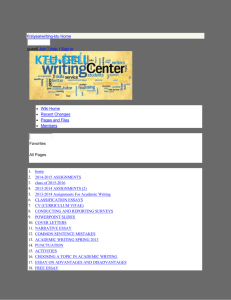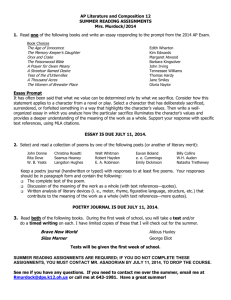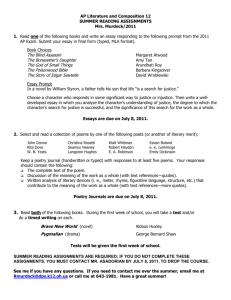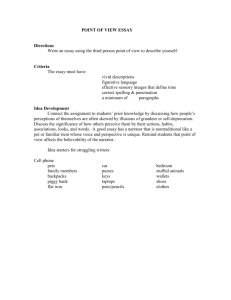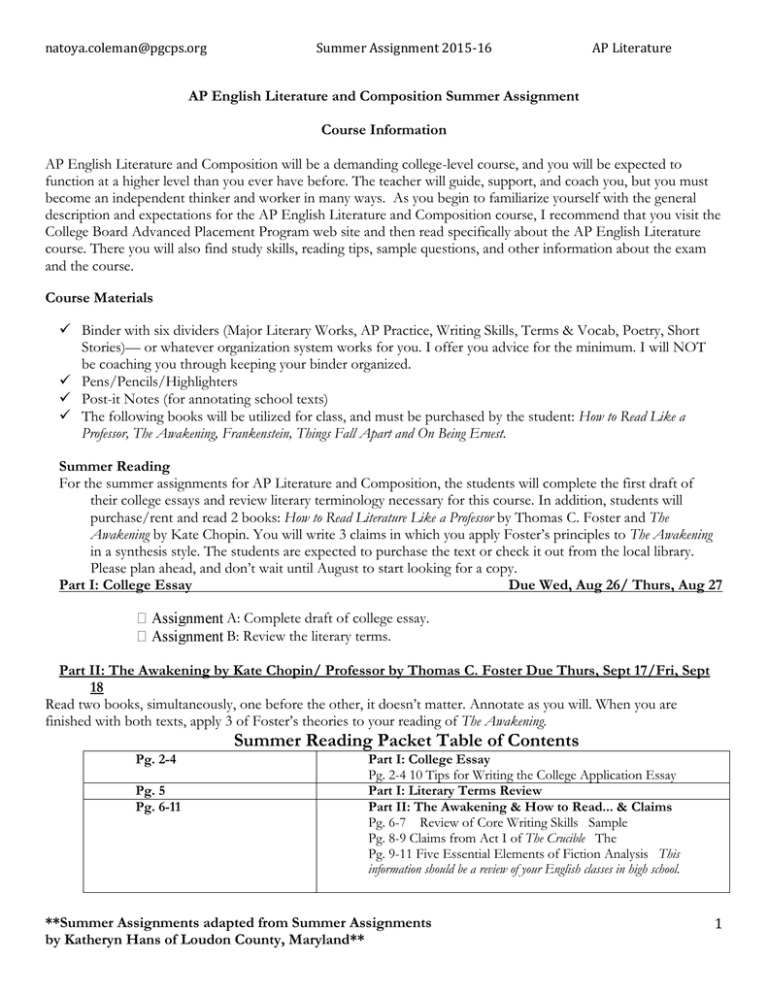
natoya.coleman@pgcps.org
Summer Assignment 2015-16
AP Literature
AP English Literature and Composition Summer Assignment
Course Information
AP English Literature and Composition will be a demanding college-level course, and you will be expected to
function at a higher level than you ever have before. The teacher will guide, support, and coach you, but you must
become an independent thinker and worker in many ways. As you begin to familiarize yourself with the general
description and expectations for the AP English Literature and Composition course, I recommend that you visit the
College Board Advanced Placement Program web site and then read specifically about the AP English Literature
course. There you will also find study skills, reading tips, sample questions, and other information about the exam
and the course.
Course Materials
Binder with six dividers (Major Literary Works, AP Practice, Writing Skills, Terms & Vocab, Poetry, Short
Stories)— or whatever organization system works for you. I offer you advice for the minimum. I will NOT
be coaching you through keeping your binder organized.
Pens/Pencils/Highlighters
Post-it Notes (for annotating school texts)
The following books will be utilized for class, and must be purchased by the student: How to Read Like a
Professor, The Awakening, Frankenstein, Things Fall Apart and On Being Ernest.
Summer Reading For the summer assignments for AP Literature and Composition, the students will complete the first draft of
their college essays and review literary terminology necessary for this course. In addition, students will
purchase/rent and read 2 books: How to Read Literature Like a Professor by Thomas C. Foster and The
Awakening by Kate Chopin. You will write 3 claims in which you apply Foster’s principles to The Awakening
in a synthesis style. The students are expected to purchase the text or check it out from the local library.
Please plan ahead, and don’t wait until August to start looking for a copy.
Part I: College Essay
Due Wed, Aug 26/ Thurs, Aug 27
A: Complete draft of college essay.
B: Review the literary terms.
Part II: The Awakening by Kate Chopin/ Professor by Thomas C. Foster Due Thurs, Sept 17/Fri, Sept
18
Read two books, simultaneously, one before the other, it doesn’t matter. Annotate as you will. When you are
finished with both texts, apply 3 of Foster’s theories to your reading of The Awakening.
Summer Reading Packet Table of Contents
Pg. 2-4
Pg. 5
Pg. 6-11
Part I: College Essay
Pg. 2-4 10 Tips for Writing the College Application Essay
Part I: Literary Terms Review
Part II: The Awakening & How to Read... & Claims
Pg. 6-7
Review of Core Writing Skills
Sample
Pg. 8-9 Claims from Act I of The Crucible
The
Pg. 9-11 Five Essential Elements of Fiction Analysis
This
information should be a review of your English classes in high school.
**Summer Assignments adapted from Summer Assignments
by Katheryn Hans of Loudon County, Maryland**
1
natoya.coleman@pgcps.org
Pg. 12
Summer Assignment 2015-16
Rubric for Claims
AP Literature
Part I: College Essay Due Wed, Aug26/ Thurs, Aug 27
Assignment A: Complete draft of college essay. Before you start, here are:
10 Tips for Writing the College Application Essay by JEREMY S. HYMAN, LYNN F. JACOBS
No subject is more fraught with anxiety for the high school senior than the essay on the college application.
Whether it is as bizarre as the University of Chicago's "How do you feel about Wednesday?” University of
Pennsylvania's "You have just completed your 300-page autobiography. Please submit page 217.” or Tufts
University's "Are We Alone?"—or whether it is a more mundane question about a formative experience you've had
in your life, or about some controversial social or political issue, students tremble at the very thought of writing the
essay and being judged on it.
We wondered what tips could be offered to ease the pain. For advice, we turned to visiting blogger Jonathan Reider,
director of college counseling at San Francisco University High School, who before that was the senior associate
director of admissions (and humanities instructor) at Stanford University. He should know; he's been on both sides
of the high school/college door. Here are his 10 best tips:
1. Be concise. Even though the Common Application main essay has only a suggested minimum of 250 words, and
no upper limit, every admissions officer has a big stack to read every day; he or she expects to spend only a couple
of minutes on the essay. If you go over 700 words, you are straining their patience, which no one should want to
do.
2. Be honest. Don't embellish your achievements, titles, and offices. It's just fine to be the copy editor of the
newspaper or the treasurer of the Green Club, instead of the president. Not everyone has to be the star at
everything. You will feel better if you don't strain to inflate yourself.
3. Be an individual. In writing the essay, ask yourself, "How can I distinguish myself from those thousands of
others applying to College X whom I don't know—and even the ones I do know?" It's not in your activities or
interests. If you're going straight from high school to college, you're just a teenager, doing teenage things. It is your
mind and how it works that are distinctive. How do you think? Sure, that's hard to explain, but that's the key to the
whole exercise.
4. Be coherent. Obviously, you don't want to babble, but I mean write about just one subject at a time. Don't try to
cover everything in an essay. Doing so can make you sound busy, but at the same time, scattered and superficial.
The whole application is a series of snapshots of what you do. It is inevitably incomplete. The colleges expect this.
Go along with them.
5. Be accurate. I don't mean just use spell check (that goes without saying). Attend to the other mechanics of good
writing, including conventional punctuation in the use of commas, semi-colons, etc. If you are writing about
Dickens, don't say he wrote Wuthering Heights. If you write about Nietzsche, spell his name right.
6. Be vivid. A good essay is often compared to a story: In many cases it's an anecdote of an important moment.
Provide some details to help the reader see the setting. Use the names (or invent them) for the other people in the
story, including your brother, teacher, or coach. This makes it all more human and humane. It also shows the reader
that you are thinking about his or her appreciation of your writing, which is something you'll surely want to do.
7. Be likable. Colleges see themselves as communities, where people have to get along with others, in dorms,
classes, etc. Are you someone they would like to have dinner with, hang out with, have in a discussion section?
**Summer Assignments adapted from Summer Assignments
by Katheryn Hans of Loudon County, Maryland**
2
natoya.coleman@pgcps.org
Summer Assignment 2015-16
AP Literature
Think, "How can I communicate this without just standing up and saying it, which is corny." Subtlety is good.
8. Be cautious in your use of humor. You never know how someone you don't know is going to respond to you,
especially if you offer something humorous. Humor is always in the eye of the beholder. Be funny only if you think
you have to. Then think again.
9. Be controversial (if you can). So many kids write bland essays that don't take a stand on anything. It is fine to
write about politics, religion, something serious, as long as you are balanced and thoughtful. Don't pretend you have
the final truth. And don't just get up on your soapbox and spout off on a sensitive subject; instead, give reasons and
arguments for your view and consider other perspectives (if appropriate). Colleges are places for the discussion of
ideas, and admissions officers look for diversity of mind.
10. Be smart. Colleges are intellectual places, a fact they almost always keep a secret when they talk about their
dorms, climbing walls, and how many sports you can play. It is helpful to show your intellectual vitality. What turns
your mind on? This is not the same thing as declaring an intended major; what matters is why that subject interests
you.
© Copyright 2010 Professors' Guide LLC. All rights reserved.
Step #1: Select the Topic
Select a topic from the list below or you may use a topic from a specific college
application.
Personal Essay Please write an essay (500-750 words) on a topic of your choice or on one of the
options listed below, and attach it to your application before submission. Please indicate your topic by
checking the appropriate box. This personal essay helps us become acquainted with you as a person and
student, apart from courses, grades, test scores, and other objective data. It will also demonstrate your
ability to organize your thoughts and express yourself
(1) Evaluate a significant experience, achievement, risk you have taken, or ethical dilemma you
have faced and its impact on you.
(2) Discuss some issue of personal, local, national, or international concern and its importance to
you.
(3) Indicate a person who has had a significant influence on you, and describe that
influence.
(4) Describe a character in fiction, a historical figure, or a creative work (as in art, music,
science, etc.) that has had an influence on you, and explain that influence.
(5) A range of academic interests, personal perspectives, and life experiences adds much
to the educational mix. Given your personal background, describe an experience that illustrates
what you would bring to the diversity in a college community or an encounter that demonstrated
the importance of diversity to you. or
State
the promptadapted
for a college
**Summer
Assignments
fromapplication.
Summer Assignments
by Katheryn Hans of Loudon County, Maryland**
3
natoya.coleman@pgcps.org
Summer Assignment 2015-16
AP Literature
Step #2: Decide on Focus
1) What is the central idea or event or idea you will use at the core of your essay?
2) What will be the focus for the:
a) Introduction
b) Body
c) Conclusion
Step #3: Complete the Draft
Complete a draft of your college essay in MLA format.
Your Name
Teacher Name
AP Literature
# Month Year
Type Prompt Here
Xxxxxxxxxxxxxxxxxxxxxxxxxxxxxxxxxxxxxxxxxxxxxxxxxxxxxxxxxxxxxxxxxxxxxxxxxxxxxxxxxxxxxxxxxxx
xxxxxxxxxxxxxxxxxxxxxxxxxxxxxxxxxxxxxxxxxxxxxx
Xxxxxxxxxxxxxxxxxxxxxxxxxxxxxxxxxxxxxxxxxxxxxxxxxxxxxxxxxxxxxxxxxxxxxxxxxxxxxx
xxxxxxxxxxxxxxxxxxxxxxxxxxxxxxxxx.
Word Count: ###
The draft of the college essay is due
at the beginning of class on Wed, Aug26/ Thurs, Aug 27.
**Summer Assignments adapted from Summer Assignments
by Katheryn Hans of Loudon County, Maryland**
4
natoya.coleman@pgcps.org
Summer Assignment 2015-16
AP Literature
Part I: Literary Analysis Review Due Thurs, Sept 17/Fri, Sept 19
This is not a conclusive list of literary terms for AP Literature; students should be
familiar with these terms at the beginning of the year. Please review the terms and
ensure that you know each definition and can identify an example. Terms with an
asterisk (*) by them are referenced on “The Essential Elements of Fiction Analysis.”
THERE WILL BE A QUIZ!!!
Narrative
Elements of Style
Point of View*
First Person narration*
Third Person Narration*
o Omniscient Narration
o Limited omniscient narration
o Free indirect discourse
Objective narrator
Unreliable narrator
Stream-of-consciousness narration
Character
Protagonist
o Hero/Heroine
Antagonist
Stock character
Dynamic character
Flat character
Round character
Foil
Confidant/Confidante
Mentor
Characterization
Direct Characterization
Indirect Characterization
Figures of Speech
Alliteration
Apostrophe
Assonances
Cacophony
Cliché
Hyperbole
Metaphor
o Mixed metaphor
Metonymy
Onomatopoeia
Oxymoron
Paradox
Personification
Rhetorical Question
Simile
Synatheasthesia
Synecdoche
Literary techniques
Antithesis
Allusion
Foreshadowing
Irony
o Verbal Irony
o Dramatic Irony
o Situational Irony
Thematic Meaning
o Imagery
o Motif
o Symbol
o Theme
o Thesis
o Tone
**Summer Assignments adapted from Summer Assignments
by Katheryn Hans of Loudon County, Maryland**
5
natoya.coleman@pgcps.org
Summer Assignment 2015-16
AP Literature
Part II: The Awakening and How to Read... Due Thurs, Sept 17/ Fri, Sept 18
Read two books, simultaneously, one before the other, it doesn’t matter. Annotate as you will. When you are
finished with both texts, apply 3 of Foster’s theories to your reading of The Awakening.
Claim Paper Guidelines (CPG) (please see page 7 for instructions on each GPG)
Core Writing Skills:
an argumentative claim
Integrating and citing evidence
your position with textual evidence
Taking a risk in your analysis
Assessment:
Each response paper will be worth 10 points, and will be assessed using the standard 4-point rubric.
Formatting
Requirements:
response paper should be one page, typed and double-spaced
each paper a standard MLA heading
each paper “The Awakening: [Foster’s chapter title]” (fill the brackets in with the appropriately title)
your “claim,” then analyze that claim in a well-developed paragraph
response cannot exceed one page in length, so make sure your analysis is concise and focused—NO
FLUFF
Content Requirements:
Claim: The claim is a statement of argument that you will prove with evidence and analysis. Your claim should be
argumentative, focused, and specific. Your claim in each response paper must address the assigned element of
literary analysis.
Analysis: Support your claim with detailed analysis. Primarily, you’ll use textual evidence as support, and you
must provide commentary on how the evidence proves your claim. You should include evidence from both texts.
The most important content requirement for these response papers: TAKEARISK. Push yourself to argue something new and expand
your analysis skills.
Sample:
Joe Smith
Teacher Name
AP Literature
# Month 2012
The Awakening: [Foster’s Chapter Title]
Claim: [Argumentative, focused, and specific]
Detailed Analysis: [Cannot exceed one page; minimum of two quotes, integrated and cited properly]
**Summer Assignments adapted from Summer Assignments
by Katheryn Hans of Loudon County, Maryland**
6
natoya.coleman@pgcps.org
Summer Assignment 2015-16
AP Literature
Core Writing Skills
Making an argumentative claim
having a heated debate with a classmate about a text. Your claim should be
argumentative, focused, and specific. You can make a claim about a character, a symbol, a motif, an
emerging theme, an element of the plot that that you’d like to explore more in-depth...something that
bothers you, frustrates you, angers you, etc. as you’re reading.
order to strengthen your claim, imagine someone challenging you and asking, “SO WHAT?”
This will help you narrow and focus your argument.
progression of an argument from weak to strong by answering the “so what?” question:
“Abigail pressures the girls into going along with her story by threatening them. ”WEAK
“So what?”
“So, Miller seems to be arguing something about the power of peer pressure.” “So what?”
“Well, it seems significant that all the accusers are young girls. Maybe Miller is really making a social argument about the
manipulative powers of groups of women.” “So what?”
“So, The Crucible is really a critique of female gender identity.” STRONG
Supporting your position with textual evidence
o For your The Awakening responses, you’re required to have at least two direct quotes from the text. Always
choose your evidence carefully.
o Integrating and citing evidence
o NO FLOATING QUOTATIONS. Quotes are “floating” if the writer has just thrown them into the
paper without integrating them into his or her own analysis.
o Use the formula below when integrating quotations: Introduce, “Quote” (cite). Analyze
*Note example above is implementing correct capitalization AND punctuation for citations.
Take a risk in your analysis Don’t play it safe and argue something simplistic and obvious in the text. Push yourself to argue
something new and expand your analysis skills. Be creative and think outside the box.
**Summer Assignments adapted from Summer Assignments
by Katheryn Hans of Loudon County, Maryland**
7
natoya.coleman@pgcps.org
Summer Assignment 2015-16
AP Literature
Sample Claims: The Awakening Response Paper #1
Score of 4
1. “The eruption of mass hysteria in The Crucible is directly related to the Puritans’ inability to intertwine reason and
religion/ superstition.”
2. “The opening of the play The Crucible by Arthur Miller follows the common misconception that all teenagers are
attracted to disobedience.”
3. “Religion is a manipulative tool used for personal gain.”
4. “Reverend Parris’s character is used by Arthur Miller as a catalyst to demonstrate the hypocrisy of religious
authority.”
5. “Betty was never physically possessed, but was scared and seeking a way of escape to ease the lasting
effect of her mother’s death.”
6. “The Crucible demonstrates the selfish tendencies of human behavior, creating a paradox and a sense of hypocrisy
even in the face of God.”
7. “The Crucible is an explanation of why ignorance is the key to survival.”
8. “Goody Ann finds pleasure seeing others in pain, because she yearns for everyone to feel the same pain she did
having lost seven of her children.”
9. “The Crucible is an unjust assessment of the basis for American democracy.”
10. “The Crucible portrays the pattern of conservative parents leading to rebellious children.”
Score of 3
1. “The Crucible is really a play concerning the effect of communism.”
2. “In The Crucible, Miller is trying to show Abigail’s inner evil.”
3. “Arthur Miller’s The Crucible is a commentary on human behavior.”
4. “Betty Parris is pretending to be asleep because she’s scared.”
5. “In Act One of The Crucible, Abigail shows multiple personalities and morals that change depending on who she is
around at a given time.”
Score of 2
1. “The accusations against Tituba in this play are supposed to represent the struggles and obstacles African slaves
had to go through, showing the cruelty of the owners of these slaves.”
2. “The Crucible is a play about a group of mischievous girls who gradually take possession of Salem.”
3. “The girls in The Crucible are all spoiled, impure, immoral liars that blame all their actions on the Devil and
witchcraft.”
4. “Although Abigail Williams is a sweet, nice girl on the outside, she is really quite manipulative and evil.”
**Summer Assignments adapted from Summer Assignments
by Katheryn Hans of Loudon County, Maryland**
8
natoya.coleman@pgcps.org
Summer Assignment 2015-16
5. “Betty was awake the whole time during the play.”
AP Literature
Score of 1
1. “Reverend Parris believes that there is a ‘faction’ that is out to get him.”
2. “The Crucible takes place between 1692 and 1693.”
3. “The night before the opening of the play, a bunch of girls were dancing in the woods.”
4. “Arthur Miller’s The Crucible takes place in the Puritan colony in Massachusetts.”
5. “One of the ‘afflicted girls’ is Betty Parris, the minister of Salem’s daughter.”
AP English Six Essential Elements of Fiction Analysis
I.
A character is a person presented in a fictional work, one fitting a type and fulfilling a function. Types of
characters: A static character does not change throughout the work, and the reader’s knowledge of that character
does not grow, whereas a dynamic character undergoes some kind of change because of the action in the plot. A
flat character embodies one or two qualities, ideas, or traits that can be readily described in a brief summary. They
are not psychologically complex characters and therefore are readily accessible to readers. Some flat characters are
recognized as stock characters; they embody stereotypes such as the "dumb blonde" or the "mean stepfather."
They become types rather than individuals. Round characters are more complex than flat or stock characters, and
often display the inconsistencies and internal conflicts found in most real people. They are more fully developed,
and therefore are harder to summarize. Functions of characters: A hero or heroine, often called the protagonist,
is the central character who engages the reader’s interest and empathy. The antagonist is the character, force, or
collection of forces that stands directly opposed to the protagonist and gives rise to the conflict of the story. A firstperson narrator may be either a major or minor character. A foil is a character who through contrast underscores
the distinctive characteristics of another. Usually a minor character serves as a foil for a major character. A
confidant/confidante is a character who is not integral to the action but who receives the intimate thoughts of the
protagonist without the use of an omniscient narrator. A mentor is a character who serves as a guide for the
protagonist.
II.
The point of view is the perspective from which the action of a novel is presented, whether the action is presented
by one character or from different vantage points over the course of the novel. These are common narrative
positions:
The omniscient narrator is a third-person narrator who sees, like God, into each character’s mind and understands
all the action going on. The limited omniscient narrator is a third-person narrator who generally reports only what
one character (often the protagonist) sees and who only reports the thoughts of that one privileged character.
The objective, or camera-eye, narrator is a third-person narrator who only reports what would be visible to a
camera. The objective narrator does not know what the character is thinking unless the character speaks of it. The
first-person narrator, who is a major or minor character in the story, tells the tale from his or her point of view.
When the first person narrator is insane, a liar, very young, or for some reason not entirely credible, the narrator is
unreliable. Some first-person narratives include multiple narrators.
The stream of consciousness technique is like first-person narration, but instead of the character telling the story,
the author places the reader inside the main character’s head and makes the reader privy to all of the character’s
**Summer Assignments adapted from Summer Assignments
by Katheryn Hans of Loudon County, Maryland**
9
natoya.coleman@pgcps.org
Summer Assignment 2015-16
thoughts as they scroll through his or her consciousness.
AP Literature
Characterization, an effect of point of view and narrative perspective, is the process by which a writer reveals the
personality of a character, making that character seem real to the reader. Authors have two major methods of
presenting characters: telling (direct characterization) and showing (indirect characterization). In direct
characterization, the author intervenes to describe and sometimes evaluate the character for the reader. For
example, the narrator may tell the reader directly what the character’s personality is like: humble, ambitious, vain,
gullible, etc. Indirect characterization allows the author to present a character talking and acting and lets the
reader infer what kind of person the character is. There are five different ways that a writer may provide indirect
characterization:
by describing how the character looks and dresses,
by allowing the reader to hear the character speak,
by revealing the character’s private thoughts and feelings,
by portraying the character’s effect on other individuals—showing how other characters feel or behave toward
the character, and
by presenting the character’s actions.
Characters can be convincing whether they are presented by showing or by telling, as long as their actions are
motivated. Motivated action by the characters occurs when the reader or audience is offered reasons for how the
characters behave, what they say, and the decisions they make. Plausible action is action by a character in a story
that seems reasonable, given the motivations presented.
III.
The setting is the physical and social context in which the action of a story occurs. The major elements of setting
are the time, the place, and the social environment that frames the characters. Setting can be used to evoke a mood
or atmosphere that will prepare the reader for what is to come. Specific elements of the setting include:
the geographical location (its topography, scenery, and physical arrangements), the occupations and daily manner
of living of the characters, the time period in which the action takes place (epoch in history or season of the year),
and the general environment of the characters (social, religious, cultural, moral, and emotional conditions and
attitudes).
IV.
The conflict in a work of fiction is the struggle within the plot between opposing forces—the issue to be resolved in
the story. The protagonist engages in the conflict with the antagonist, which may take the form of a character,
society, nature, or an aspect of the protagonist’s personality. Thus, conflict may be external, a struggle against some
outside force, another character, society as a whole, or some natural force; or internal, a conflict between forces or
emotions within one character.
V.
Style is the writer's distinctive manner of arranging words to suit his or her ideas and purpose in writing. The
unique imprint of the author's personality upon his or her writing, style is the product of an author's way of
arranging and presenting ideas. Elements of style include:
Syntax is the sentence structure, sentence variety, sentence arrangement, word order, parallelism, spelling, grammar
conventions (or lack thereof), phrasing, punctuation, and repetition. Diction is word choice with its denotation
and connotation as well as concrete and abstract details.
**Summer Assignments adapted from Summer Assignments
by Katheryn Hans of Loudon County, Maryland**
10
natoya.coleman@pgcps.org
Summer Assignment 2015-16
AP Literature
Tone, the writer’s or speaker’s attitude toward the subject, the audience, himself, or herself, provides the emotional
coloring of meaning of a work. Figurative Language relies on comparison and includes metaphor, simile,
hyperbole, understatement, personification, synecdoche, metonymy, paradox, and allusion. Imagery—categorized as
auditory, gustatory, kinetic, olfactory, organic, tactile, and visual—is often contrasted (light vs. dark, apathy vs.
energy, sweet vs. sour) or repeated.
Point of View can be sorted into first-person, third-person, omniscient, stream-of-consciousness, narrative,
childhood, adulthood, personal, and impersonal. Organization is the structure or form, which can utilize contrast
or similarity and be classified as formal, informal, logical, or chaotic.
Musicality describes the sound of language—euphony, cacophony, or monotony. Rhyme is the repetition of
sounds and may be formal, informal, traditional, unconventional, and completely absent. Use of Time may include
flashback, flash-forward, or a framed story with narration that is chronological, realistic, synchronous,
asynchronous, magical, or circular. Repetition can involve words, phrases, clauses, sentences, images, structure, or
grammatical type.
VI.
Theme is the central meaning or dominant idea in a literary work. A theme provides a unifying point around which
the plot, characters, setting, point of view, symbols, and other elements of a work are organized. It is important not
to mistake the theme for the topic of the work; the theme expresses an opinion about an abstract concept (i.e.
freedom, jealousy, guilt, unrequited love, self-pity).
Theme should be written in a complex statement: The [genre] [title] by [author] is about [topic/abstract concept]
and reveals that [opinion].
**Summer Assignments adapted from Summer Assignments
by Katheryn Hans of Loudon County, Maryland**
11
natoya.coleman@pgcps.org
Summer Assignment 2015-16
AP Literature
Name _____________________________ Summer Assignment Part II: The Awakening/ Apply Foster’s Principles
Response Papers
Rubric
____/10
Claim 1
____/10
Claim 2
____/10
Claim 3
____/30
Total Points for Assignment Part II
**Summer Assignments adapted from Summer Assignments
by Katheryn Hans of Loudon County, Maryland**
4 (10)
Argumentative thesis that shows significant risks.
Detailed and insightful analysis. Evidence is
chosen thoughtfully and integrated smoothly.
Effective organization and focus, with smooth
transitions. Unique and consistent writer’s voice.
No more than a few mechanical flaws that do
not reduce the impact of the paper.
3.5 (9)
Contains characteristics from both categories 4
and 3.
3 (8)
Clear thesis that makes a claim but lacks risk.
Effective analysis but lacks some detail and
insight. Effective use of evidence; mostly
integrated smoothly. Adequate organization and
focus; some transitions. Emerging, if
inconsistent, writer’s voice. Several mechanical
flaws that show some lack of attention to detail.
2.5 (7)
Contains characteristics from both categories 3
and 2.
2 (6)
Thesis is too vague and simplistic/formulaic; no
risk. Some analysis, but mostly summary. Weak
evidence; choppy quote integration. Loss of
focus in organization; missing transitions.
Generally absent writer’s voice.
Mechanical flaws that show definite lack of
attention to detail.
1(5)
Thesis is difficult to find.
Lack of analysis; all
summary.
Lack of evidence; missing quotes
and/or not integrated. Weak organization; no
transitions. No writer’s voice. Mechanical
flaws that obscure meaning.
12

![Submission 68 [doc]](http://s3.studylib.net/store/data/008000926_1-fed8eecce2c352250fd5345b7293db49-300x300.png)
